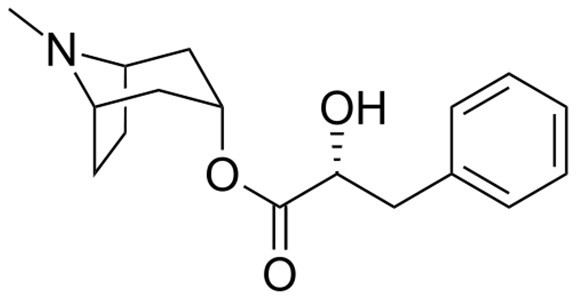Littorine
The kinetics of Littorine biosynthesis were in agreement with the role of this compound as a direct precursor of hyoscyamine biosynthesis.
Inquire / Order:
manager@chemfaces.com
Technical Inquiries:
service@chemfaces.com
Tel:
+86-27-84237783
Fax:
+86-27-84254680
Address:
1 Building, No. 83, CheCheng Rd., Wuhan Economic and Technological Development Zone, Wuhan, Hubei 430056, PRC
Providing storage is as stated on the product vial and the vial is kept tightly sealed, the product can be stored for up to
24 months(2-8C).
Wherever possible, you should prepare and use solutions on the same day. However, if you need to make up stock solutions in advance, we recommend that you store the solution as aliquots in tightly sealed vials at -20C. Generally, these will be useable for up to two weeks. Before use, and prior to opening the vial we recommend that you allow your product to equilibrate to room temperature for at least 1 hour.
Need more advice on solubility, usage and handling? Please email to: service@chemfaces.com
The packaging of the product may have turned upside down during transportation, resulting in the natural compounds adhering to the neck or cap of the vial. take the vial out of its packaging and gently shake to let the compounds fall to the bottom of the vial. for liquid products, centrifuge at 200-500 RPM to gather the liquid at the bottom of the vial. try to avoid loss or contamination during handling.
Sci Rep.2024, 14(1):3684.
Molecules.2021, 26(2):E255.
Bull. Natl. Mus. Nat. Sci.2021, 47(2),109-114.
PLoS One.2018, 13(4):e0195642
Front Plant Sci.2022, 13: 905275.
Plant Growth Regulation2020, 90(2):383-392
Cell Chem Biol.2019, 26(1):27-34
Research Square2024, rs-4398438
Eur J Pharmacol.2020, 889:173589.
Anal Biochem.2019, 569:10-15
Related and Featured Products
Chem Biol. 2006 May;13(5):513-20.
Functional genomic analysis of alkaloid biosynthesis in Hyoscyamus niger reveals a cytochrome P450 involved in littorine rearrangement.[Pubmed:
16720272]
Tropane alkaloids are valuable pharmaceutical drugs derived from solanaceous plants such as Hyoscyamus niger (black henbane). The biosynthesis of these molecules, including the nature of the enigmatic rearrangement of (R)-Littorine to (S)-hyoscyamine, is not completely understood.
METHODS AND RESULTS:
To test the hypothesis that a cytochrome P450 enzyme is involved in this rearrangement, we used virus-induced gene silencing to silence a cytochrome P450, CYP80F1, identified from H. niger roots by EST sequencing. Silencing CYP80F1 resulted in reduced hyoscyamine levels and the accumulation of Littorine. Hyoscyamine was observed in CYP80F1-expressing tobacco hairy roots supplied with (R)-Littorine. Expression in yeast confirmed that CYP80F1 catalyzes the oxidation of (R)-Littorine with rearrangement to form hyoscyamine aldehyde, a putative precursor to hyoscyamine, and without rearrangement to form 3'-hydroxyLittorine.
CONCLUSIONS:
Our data strongly support the involvement of CYP80F1 in the rearrangement of Littorine to hyoscyamine.
Phytochemistry. 2012 Feb;74:105-14.
Norlittorine and norhyoscyamine identified as products of littorine and hyoscyamine metabolism by (13)C-labeling in Datura innoxia hairy roots.[Pubmed:
22083085]
The presence of two compounds, norLittorine and norhyoscyamine, has been reported in leaves and roots of Datura innoxia; however their metabolic origin in the tropane alkaloid pathway has remained unknown. Precise knowledge of this pathway is a necessary pre-requisite to optimize the production of hyoscyamine and scopolamine in D. innoxia hairy root cultures.
METHODS AND RESULTS:
The exact structure of norLittorine and norhyoscyamine was confirmed by LC-MS/MS and NMR analyses. Isotopic labeling experiments, using [1-(13)C]-phenylalanine, [1'-(13)C]-Littorine and [1'-(13)C]-hyoscyamine, combined with elicitor treatments, using methyl jasmonate, coronalon and 1-aminocyclopropane-1-carboxylic acid, were used to investigate the metabolic origin of the N-demethylated tropane alkaloids.
CONCLUSIONS:
The results suggest that norLittorine and norhyoscyamine are induced under stress conditions by conversion of Littorine and hyoscyamine. We propose the N-demethylation of tropane alkaloids as a mechanism to detoxify cells in overproducing conditions.
Chembiochem. 2009 Sep 21;10(14):2382-93.
Mechanistic insights into the cytochrome P450-mediated oxidation and rearrangement of littorine in tropane alkaloid biosynthesis.[Pubmed:
19693762]
During the biosynthesis of certain tropane alkaloids, Littorine (1) is rearranged to hyoscyamine (3).
METHODS AND RESULTS:
Recent evidence indicates that this isomerisation is a two-step process in which the first step is an oxidation/rearrangement to give hyoscyamine aldehyde (2). This step is catalysed by CYP80F1, a cytochrome P450 enzyme, which was recently identified from the plant Hyoscyamus niger; CYP80F1 also catalyses the hydroxylation of Littorine at the 3'-position. The mechanisms of the reactions catalysed by CYP80F1 were probed with synthetic deutero and arylfluoro analogues of 1. Measurement of the primary kinetic isotope effects indicates that C3' hydrogen abstraction is the rate-limiting step for the oxidation/rearrangement of natural Littorine, and for the 3'-hydroxylation reaction of the unnatural S enantiomer of Littorine. The character of the intermediates in the oxidation/rearrangement and hydroxylation reaction was probed with the use of arylfluorinated analogues of (R)-Littorine (natural stereoisomer) and (S)-Littorine (unnatural stereoisomer) as substrates for CYP80F1. The relative conversions of ortho-, meta- and para-fluoroLittorine analogues were used to obtain information on the likely intermediacy of either a benzylic radical or benzylic carbocation intermediate.
CONCLUSIONS:
The data suggest that hydroxylation takes place via a benzylic carbocation intermediate, whereas the product profile arising from rearrangement is more consistent with a benzylic radical intermediate.



